| |||||
| Decades: | |||||
|---|---|---|---|---|---|
| See also: | Other events of 1683 History of China • Timeline • Years | ||||
Events from the year 1683 in China .
| |||||
| Decades: | |||||
|---|---|---|---|---|---|
| See also: | Other events of 1683 History of China • Timeline • Years | ||||
Events from the year 1683 in China .
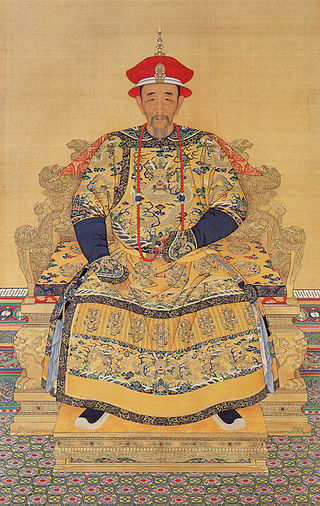
The Kangxi Emperor, also known by his temple name Emperor Shengzu of Qing, personal name Xuanye, was the third emperor of the Qing dynasty, and the second Qing emperor to rule over China proper. His reign of 61 years makes him the longest-reigning emperor in Chinese history and one of the longest-reigning rulers in history. He is considered one of China's greatest emperors.

The Yongzheng Emperor, also known by his temple name Emperor Shizong of Qing, personal name Yinzhen, was the fourth emperor of the Qing dynasty, and the third Qing emperor to rule over China proper.
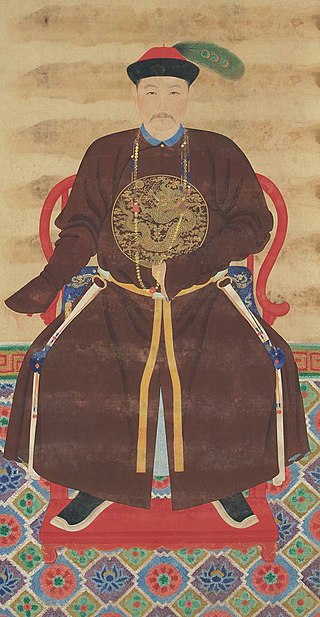
Yunsi, born as Yinsi, was a Manchu prince of the Qing dynasty in China. The eighth son of the Kangxi Emperor, Yunsi was a pivotal figure in the power struggle over the succession to his father's throne. Yunsi was believed to be favoured by most officials in the imperial court to be the next emperor but ultimately lost the struggle to his fourth brother Yinzhen, who became the Yongzheng Emperor.

The Revolt of the Three Feudatories, also known as the Rebellion of Wu Sangui, was a rebellion lasting from 1673 to 1681 in early Qing dynasty of China, during the early reign of the Kangxi Emperor. The revolt was led by Wu Sangui, Shang Zhixin and Geng Jingzhong, the three Han Chinese lords of Yunnan, Guangdong and Fujian provinces whose hereditary titles were given for defecting and helping the Manchus conquer China, who rebelled after the Qing central government started removing their fiefdoms. The feudatories were supported by Zheng Jing's Kingdom of Tungning in Taiwan, which sent forces to invade Mainland China. Additionally, minor Han military figures, such as Wang Fuchen and the Chahar Mongols, also revolted against Qing rule.
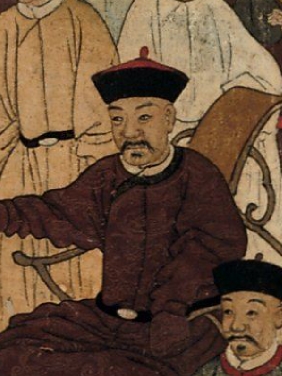
Shi Lang (1621–1696), Marquis Jinghai, also known as Secoe or Sego, was a Chinese admiral who served under the Ming and Qing dynasties in the 17th century. He was the commander-in-chief of the Qing fleets which destroyed the power of Zheng Chenggong's descendants in the 1660s, and led the conquest of the Zheng family's Kingdom of Tungning in Taiwan in 1683. Shi later governed part of Taiwan as a marquis.
The Yongli Emperor, personal name Zhu Youlang, was the fourth and last emperor of the Southern Ming dynasty, reigning in turbulent times when the former Ming dynasty was overthrown and the Manchu-led Qing dynasty progressively conquered the entire China proper. He led the remnants of the Ming loyalists with the assistance of peasant armies to resist the Qing forces in southwestern China, but he was then forced to exile to Toungoo Burma and eventually captured and executed by Wu Sangui in 1662. His era title "Yongli" means "perpetual calendar".

Zheng Jing, Prince of Yanping, courtesy names Xianzhi and Yuanzhi, pseudonym Shitian, was initially a Southern Ming military general who later became the second ruler of the Tungning Kingdom of Taiwan by succeeding his father Koxinga's hereditary title of "Prince of Yanping", reigned as a dynastic monarch of the kingdom from 1662 to 1681.
Hongshi was a Manchu prince of the Qing dynasty. Born to the ruling Aisin Gioro clan as the third son of the Yongzheng Emperor, he was banished from the imperial clan in 1725, ostensibly for supporting his uncle Yunsi, a political rival of his father. He died in disgrace in 1727 but was later posthumously restored to the imperial clan by his younger brother, the Qianlong Emperor.

Empress Xiaogongren, of the Manchu Plain Yellow Banner Uya clan, was a posthumous name bestowed to the consort of Xuanye, the Kangxi Emperor and mother of Yinzhen, the Yongzheng Emperor. She was honoured as Empress Dowager Renshou during the reign of her son and posthumously honoured as empress, although she never held the rank of empress consort during her lifetime.
The Battle of Penghu was a naval battle fought in 1683 between the Qing dynasty and the Kingdom of Tungning. The Qing admiral Shi Lang led a fleet to attack the Tungning forces in Penghu. Each side possessed more than 200 warships. The Tungning admiral Liu Guoxuan was outmaneuvered by Shi Lang, whose forces outnumbered him three to one. Liu surrendered when his flagship ran out of ammunition and fled to Taiwan. The loss of Penghu resulted in the surrender of Zheng Keshuang, the last king of Tungning, to the Qing dynasty.

Yuntang, born Yintang, was a Manchu prince of the Qing dynasty. He was the ninth son of the Kangxi Emperor and an ally of his eighth brother Yunsi, who was the main rival to their fourth brother Yinzhen in the power struggle over the succession. In 1722, Yinzhen succeeded their father and became historically known as the Yongzheng Emperor, after which he started purging his former rivals. In 1725, the Yongzheng Emperor stripped Yuntang off his beizi title, banished him from the Aisin Gioro clan, and imprisoned him in Baoding. Yuntang died under mysterious circumstances later. In 1778, the Qianlong Emperor, who succeeded the Yongzheng Emperor, posthumously rehabilitated Yuntang and restored him to the Aisin Gioro clan.

Zhu Shugui, courtesy name Tianqiu (天球) and art name Yiyuanzi (一元子), the Prince of Ningjing (寧靖王), was a royal member of the Ming and the last of the pretenders to the throne of Southern Ming after the execution of the Yongli Emperor in 1662. He took shelter to the Kingdom of Tungning in Taiwan after mainland China completely fell under the control of Manchu-led Qing dynasty. Despite his status as a royal member, he virtually shared no political power with the Zheng dynasts whom were the actual rulers of the kingdom. After the Qing forces successfully annexed Taiwan in 1683, he committed suicide. Nowadays there is a temple dedicated to the prince in Lujhu Township. Inside the temple is written Zhu's death poem.
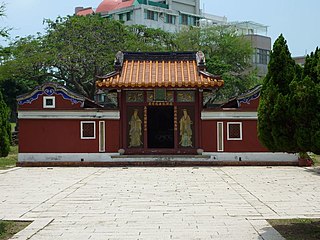
The Temple of the Five Concubines, known also by alternative names including the Temple of the Five Noble Ladies, is a temple in West Central District, Tainan, Taiwan. It was built in front of the tomb of the five concubines of Zhu Shugui, the Ming Prince of Ningjing, who killed themselves in 1683 to accompany him in death. It is registered as a first-class historic site by the Republic of China government.

Yao Qisheng, courtesy name Xizhi, was a Chinese regional official, diplomat, and statesman during the reign of the Kangxi Emperor in the Qing dynasty. Yao was a pivotal figure in the Qing empire's annexation of Taiwan.
Zhu Yihai, courtesy name Juchuan (巨川), art name Hengshan (恆山) and Changshizi (常石子), was a regent of the Southern Ming dynasty from 1645 to 1653.
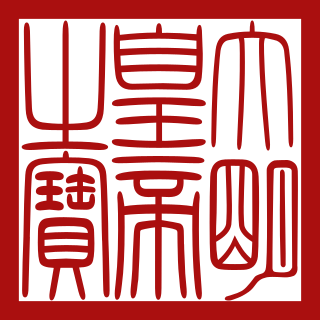
The House of Zhu was a Chinese imperial ruling house of the Ming dynasty (1368–1644) and Southern Ming dynasty (1644–1662). They also held the title "Duke of Wu" and "King of Wu" from 1361 to 1368 as well as "Marquis of Zhu" from 1725 to 1929.

Yun'e, born Yin'e, was a Manchu prince of the Qing dynasty of China. He was a relatively unremarkable prince who was primarily known to be a crony of his older brother Yunsi.
The Marquis of Extended Grace was a title held by a descendant of the imperial family of the Ming dynasty (1368–1644) during the subsequent Qing dynasty (1644–1912). Holders of this title were also called the Marquis of Zhu from the surname of the Ming imperial family. The marquis presided at memorial ceremonies held twice a year at the Ming tombs near Beijing.

The Grand Matsu Temple, also known as the Datianhou or Great Queen of Heaven Temple, is a temple to the Chinese Goddess Mazu, who is the Goddess of Sea and Patron Deity of fishermen, sailors and any occupations related to sea/ocean. The temple is located in the West Central District of Tainan on Taiwan.
Tao Runai, courtesy name Zhongtiao (仲調) and Xieyou (燮友), art name Mi'an (密庵) and Shixinong (石溪農), dharma name Rentoutuo (忍头陀), was a Chinese official, scholar, calligrapher and Buddhist monk who resisted the Qing conquest of China in the 17th century. He spent most of his life during the Manchu conquest of China and anti-Qing activities after the Ming dynasty had been overthrown.
案發生於乾隆十六年〔一七五一年)的偽奏稿案,就是對遏制言路的高壓政策的一種反抗。孫[嘉]淦係康熙五十一一年〈一七一三年)進士,曾任侍郎、尚書、督撫等職,為官清廉剛正。